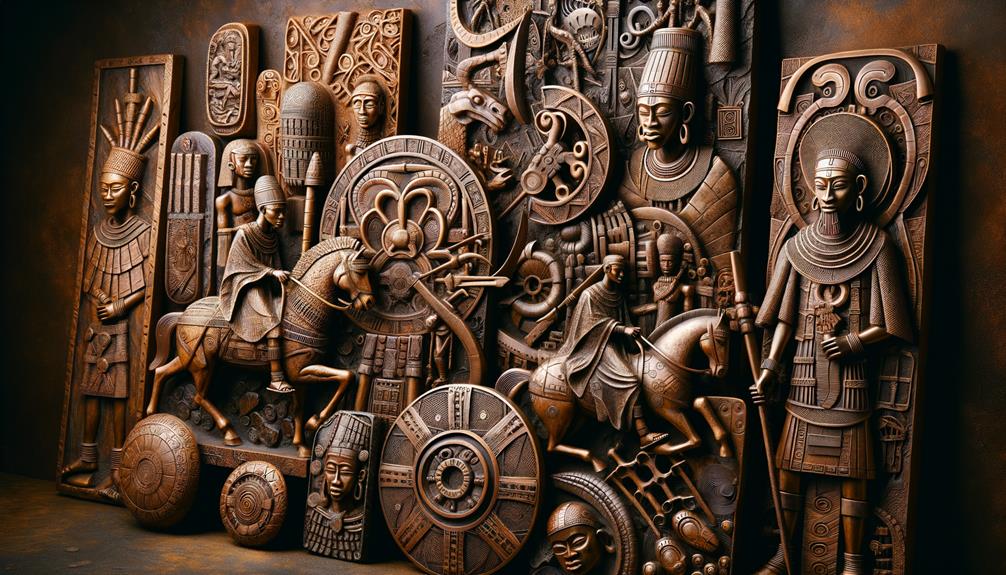The Benin Bronzes tell an important story about Nigeria's past. These detailed artifacts are a testament to the rich cultural and spiritual traditions, the power, and the glory of the Benin Kingdom. But there's a twist in this tale. In 1897, more than 900 of these precious items were taken by British forces, a blatant act of cultural theft that left a deep, indelible mark on the kingdom's heritage. Today, these treasures are scattered across the globe, with most of them housed in the British Museum, which has resulted in a heated debate over the remnants of colonial-era exploitation.
However, there's a glimmer of hope. Germany recently returned 22 of these artifacts to Nigeria, a significant step towards rectifying past wrongs. As this journey continues, it reveals an increasingly fascinating narrative about this vibrant artistic history. So, let's keep our eyes peeled, as there's more to come in this unfolding saga.
Historical Significance of Benin Bronzes
Let's talk about the Benin Bronzes, which are so much more than beautiful works of art. These detailed sculptures, made of brass and bronze, were central to the spiritual and political life of the Benin Kingdom. They were crafted by expert guilds and represented power and prestige. These sculptures were used in important ceremonies, such as ancestral worshipping and to confirm a new Oba's rule.
So, you see, these artifacts were also a form of historical documentation. They tell the story of the African Kingdom of Benin, their traditions, and their interactions with surrounding territories. The Benin Bronzes are a testament to the rich heritage of Benin, and they play a crucial role in helping us understand the culture and politics of ancient Nigeria. The return of these artifacts to Nigeria is of great historical importance and it stirs up a strong sense of national pride.
British Invasion and Art Plundering
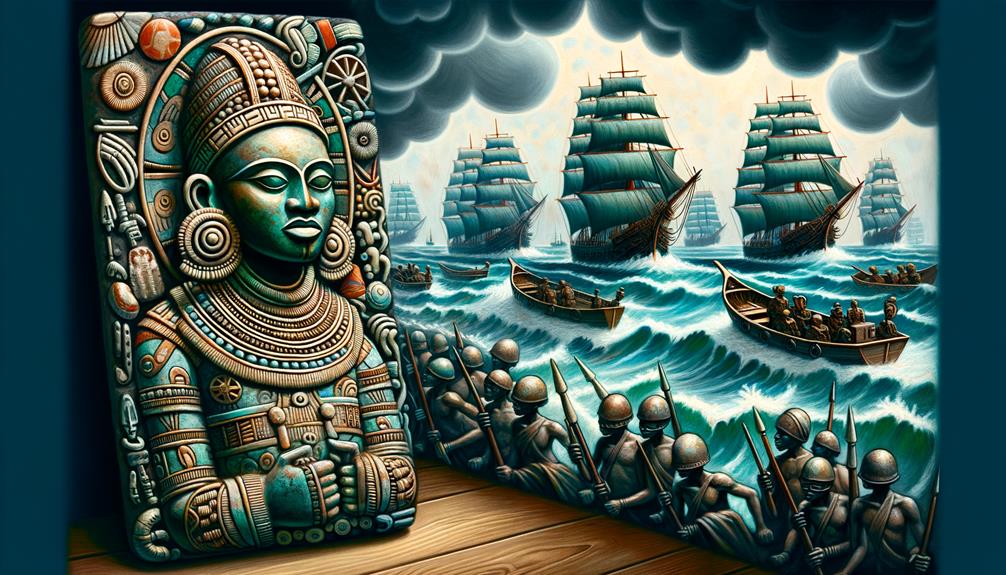
Let's talk about the Benin Bronzes, and a rather grim episode from 1897. British forces, driven by revenge and avarice, seized more than 900 of these precious artifacts from Benin City. This brutal military campaign was one of many instances of cultural looting, leaving Benin bereft of its priceless treasures. Imagine the significance of these items – from brass cast plaques to royal attire, each one a testament to the noteworthy cultural legacy and artistic skill of the Benin people. The loss of these treasures is deeply felt even today. The British Museum currently holds over 100 of these looted pieces, a grim reminder of a regrettable past. Incidents like these highlight the importance of rethinking how we handle cultural heritage, underscoring the need for restitution.
Controversy and Global Distribution

When we talk about the Benin Bronzes, it's tough to sidestep the contentious history tied to colonial-era theft. These artifacts are now spread out all over the world, held in museums and private collections, which makes the situation even more complicated. In this complex scenario, there are ongoing attempts to return these taken items back to their original home. This is a crucial part of addressing the wrongs of colonialism.
Colonial Era Looting
The colonial period saw a significant amount of cultural theft, a prime example of which is the removal of over 5,000 ancient items from Nigeria, including the famous Benin Bronzes. This issue has stirred up a worldwide debate and calls for these items to be returned to their homeland. Institutions such as the British Museum have been major holders of these cultural gems, which serve as a harsh reminder of the pillaging that took place during the colonial period. The bulk of the Benin Bronzes were seized in 1897 when British soldiers stormed Benin City, an act that has come under heavy fire as a breach of cultural rights. Recently, progress has been made as Germany took the step to return 22 of the Benin Bronzes to Nigeria, a move that has been praised as a positive action towards righting the wrongs of the past and a hopeful indicator for the return of more artifacts.
Artifacts Global Distribution
The Benin Bronzes are more than just outstanding works of art. These pieces are at the heart of an intense debate about the return of stolen artifacts. So, where exactly can you find them around the world?
Well, you'll find the largest collection at the British Museum, home to over 900 of these stunning pieces. There are also a good many of them showcased in museums across America and Europe. Plus, a few have even made their way into private collections all around the globe. Quite the jet-setters, these bronzes!
In a noteworthy move, Germany recently handed back 22 pieces to Nigeria. This act has been hailed as a significant stride towards artifact restitution.
This whole issue throws a spotlight on the big question of cultural heritage ownership. It makes us reflect on what role museums play in addressing their colonial pasts and the issue of returning stolen artifacts. The widespread distribution of the Benin Bronzes certainly adds fuel to this ongoing conversation.
Ongoing Repatriation Efforts
Let's chat about the worldwide spread of the Benin Bronzes and how steps towards returning them to their homeland have really picked up pace lately. The recent return of 22 Benin Bronzes by Germany to Nigeria, for example, is a noteworthy step in making up for the colonial-era plundering of African artifacts. But Germany is not alone in this. Major players like the Metropolitan Museum and the Smithsonian are also doing their bit.
The Benin Dialogue Group has been instrumental in making these returns happen. Here's a quick look at the numbers:
| Country | Number of Benin Bronzes Returned |
|---|---|
| Germany | 22 |
| US (Metropolitan Museum) | To be confirmed |
| US (Smithsonian) | To be confirmed |
| Total | 22 + To be confirmed |
This ongoing process of returning stolen artifacts is a testament to the vital role of restitution and global teamwork in restoring these treasures to their rightful owners.
Nigerias Fight for Restitution
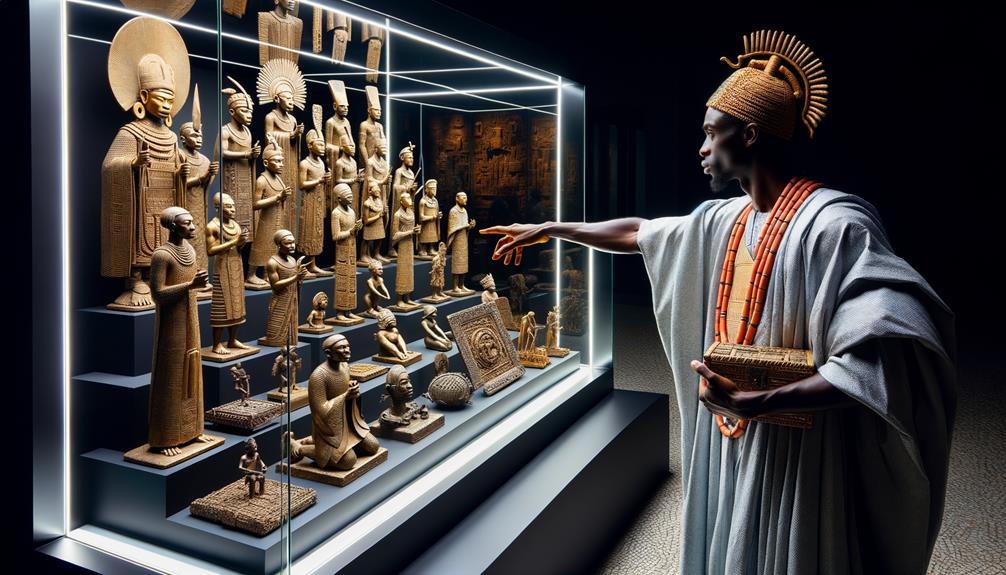
Nigeria's fight for restitution is a gripping tale of defiance and recovery. The nation's quest to take back its stolen art isn't just about physical retrieval; it's part of a larger pursuit for cultural and historical justice. The comeback of the Benin Bronzes stands as more than just a win. It marks an important stride towards acknowledging past offenses and mending the wounds inflicted during the colonial period.
History of Art Theft
In the muddy domain of colonial art theft, Nigeria has been steadfast in its pursuit to reclaim over 5,000 of its ancient artifacts, most notably the Benin Bronzes. These were stolen by British forces in 1897 from the historical Kingdom of Benin. A significant chunk of these stolen pieces has been held by the British Museum, placing it at the forefront of ongoing restitution talks. These talks have been sparked by Nigeria's persistent calls for justice, symbolizing their stand against historical wrongs.
- Colonial art theft is a grim period in global history, with the theft of the Benin Bronzes standing out as a key instance.
- Nigeria's pleas for restitution have been resonating for well over a decade.
- The British Museum plays a pivotal role in these restitution talks.
- The act of returning stolen artifacts acknowledges and aims to rectify historical wrongs.
Restitution Efforts Progress
Nigeria's long-standing quest to reclaim the Benin Bronzes is finally seeing some positive results. A major breakthrough recently was when Germany decided to send back 22 bronzes that were taken during the colonial era. This move by Germany is a step towards reckoning with and making amends for the colonial past. It has also set a new standard, causing other institutions like the Metropolitan Museum and the Smithsonian to consider returning their own collection of seized artifacts.
| Institution | Artifact | Status |
|---|---|---|
| Germany | 22 Benin Bronzes | Returned |
| Metropolitan Museum | Undisclosed | Thinking about it |
| Smithsonian | Undisclosed | Thinking about it |
The return of the Benin Bronzes is a crucial milestone in correcting historical injustices. Restitution, in this case, isn't simply about getting back artifacts; it's about restoring respect and fairness to Nigeria.
Returned Bronzes: Recent Developments
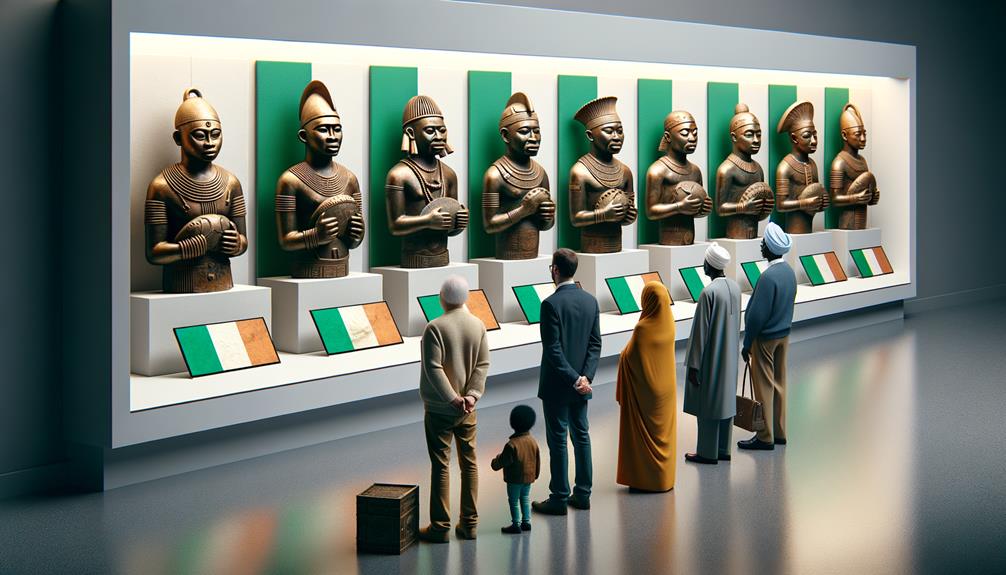
Germany recently made a remarkable decision to return 22 Benin Bronzes to Nigeria, a key move in addressing its controversial colonial past. This act is just the tip of the iceberg, with plans to eventually return all 1,130 Benin Bronzes that currently reside in German collections. This admirable decision not only acknowledges the mistakes made during colonial times, but it also paves the way for other countries and institutions to follow suit.
The importance of this story can be broken down into several key points:
- It signals a change in the approach to handling Nigerian artifacts that were taken unlawfully.
- It represents a crucial step in coming to terms with Germany's past colonial wrongdoings.
- It demonstrates the growing readiness of institutions to return stolen artifacts.
- It creates a model for other countries and institutions to confront and address their colonial histories.
Impact on Nigerian Culture and Heritage
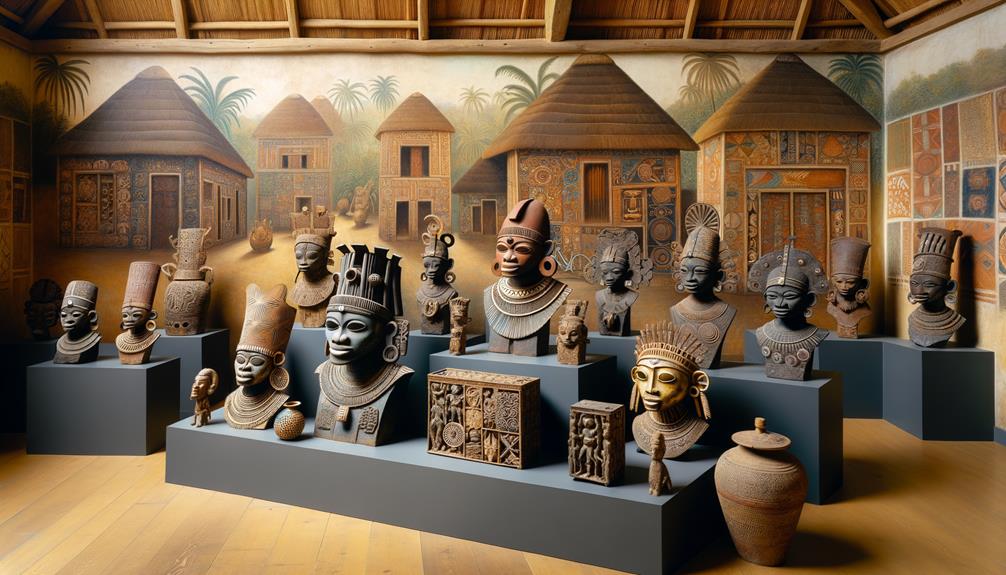
Acknowledging Germany's actions to make amends for past colonial wrongs is a significant step. Yet, it's just as necessary to consider the ripple effect this has on Nigeria, especially in terms of reclaiming and preserving its cultural and historical legacy. When the Benin Bronzes return home, it's not just about bringing back physical objects. It's an act of restoring Nigerian culture and reinforcing ties to a rich artistic past.
The return of these precious historical items boosts cultural pride and helps Nigerians understand their artistic history more deeply. At the same time, it breathes new life into Nigerian cultural organizations, promoting national unity. It also encourages communities to protect their artistic heritage, ensuring these traditions continue to thrive for future generations.
Therefore, the effects of this action are profound. It fuels a revival of cultural pride, breathing new life into Nigeria's rich artistic traditions.
Frequently Asked Questions
Why Are the Benin Bronzes Important to Nigeria?
The Benin Bronzes hold a special place in Nigeria's heart, representing a rich tapestry of its cultural legacy. Having been taken during the colonial era, their eventual return is perceived as a step towards re-establishing a connection with the country's historical roots and identity. Essentially, their significance lies in their ability to remind Nigeria of a past that once was.
What Artifacts Were Stolen From Benin?
A vast number of valuable artifacts were taken from Benin, comprising of items like brass plaques, commemorative heads, various figures, pieces of royal regalia, and personal ornaments. These objects hold a profound significance for me, as they represent the vibrant history and culture that's woven into the fabric of my Nigerian roots.
What Was Displayed on the Benin Bronzes?
The Benin Bronzes are a lot more than just pieces of art. They depict elaborate patterns that represent royal attire, figures of humans and animals, and even scenes from historical events. They offer a glimpse into the history of the Kingdom, including its interactions with surrounding realms.
What Is the Significance of Benin Art in Nigerian History?
When you think about Nigerian history, you can't help but be struck by the rich tapestry of Benin art. This art isn't just something to admire with the eyes; it's a key piece of Nigeria's grand historical puzzle. It tells us about tradition, societal values, and events from the past. It's like a visual storybook, giving us a glimpse into what life was like long ago. So, in a nutshell, that's why Benin art is so important – it's a living, breathing part of the country's vibrant historical and cultural legacy.

